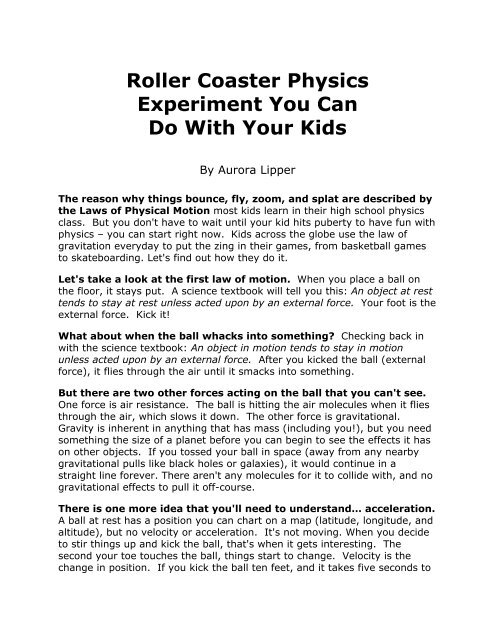Roller Coaster Physics Experiment You Can Do With Your Kids
Roller Coaster Physics Experiment You Can Do With Your Kids
Roller Coaster Physics Experiment You Can Do With Your Kids
You also want an ePaper? Increase the reach of your titles
YUMPU automatically turns print PDFs into web optimized ePapers that Google loves.
<strong>Roller</strong> <strong>Coaster</strong> <strong>Physics</strong><strong>Experiment</strong> <strong>You</strong> <strong>Can</strong><strong>Do</strong> <strong>With</strong> <strong>You</strong>r <strong>Kids</strong>By Aurora LipperThe reason why things bounce, fly, zoom, and splat are described bythe Laws of Physical Motion most kids learn in their high school physicsclass. But you don't have to wait until your kid hits puberty to have fun withphysics – you can start right now. <strong>Kids</strong> across the globe use the law ofgravitation everyday to put the zing in their games, from basketball gamesto skateboarding. Let's find out how they do it.Let's take a look at the first law of motion. When you place a ball onthe floor, it stays put. A science textbook will tell you this: An object at resttends to stay at rest unless acted upon by an external force. <strong>You</strong>r foot is theexternal force. Kick it!What about when the ball whacks into something? Checking back inwith the science textbook: An object in motion tends to stay in motionunless acted upon by an external force. After you kicked the ball (externalforce), it flies through the air until it smacks into something.But there are two other forces acting on the ball that you can't see.One force is air resistance. The ball is hitting the air molecules when it fliesthrough the air, which slows it down. The other force is gravitational.Gravity is inherent in anything that has mass (including you!), but you needsomething the size of a planet before you can begin to see the effects it hason other objects. If you tossed your ball in space (away from any nearbygravitational pulls like black holes or galaxies), it would continue in astraight line forever. There aren't any molecules for it to collide with, and nogravitational effects to pull it off-course.There is one more idea that you'll need to understand… acceleration.A ball at rest has a position you can chart on a map (latitude, longitude, andaltitude), but no velocity or acceleration. It's not moving. When you decideto stir things up and kick the ball, that's when it gets interesting. Thesecond your toe touches the ball, things start to change. Velocity is thechange in position. If you kick the ball ten feet, and it takes five seconds to
go the distance, the average speed of the ball is 2 feet per second (about1.4 MPH).The trickier part of this scenario has to do with acceleration, which isthe change of velocity. When you drive on the freeway at a constant 65MPH, your acceleration is zero. <strong>You</strong>r speed does not change, so you have noacceleration. <strong>You</strong>r position is constantly changing, but you have constantspeed. When you get on the freeway, your speed changes from zero to 65MPH in ten seconds. <strong>You</strong>r acceleration is greatest when your foot first hitsthe gas – when your speed changes the most.There's an interesting effect that happens when you travel in acurve. <strong>You</strong> can feel the effect of a different type of acceleration when yousuddenly turn your car to the right – you will feel a push to the left. If youare going fast enough and you take the turn hard enough, you can getslammed against the door. So - who pushed you?Think back to the first law of motion. An object in motion tends to stayin motion unless acted upon by an external force. This is the amazing part –the car is the external force. <strong>You</strong>r body was the object in motion, wanting tostay in motion in a straight line. The car turns, and your body still tries tomaintain its straight path, but the car itself gets in the way. When you slaminto the car door, the car is turning itself into your path, forcing you tochange direction.This effect is true when you travel in a car or in a roller coaster. It'sthe reason the water stays in the bucket when you swing it over your head.Physical motion is everywhere, challenging toddlers learning to walk as wellas Olympic downhill skiers to go the distance.Let's try these ideas out.Bucket Splash Fill a bucket half-full with water. Grasp the handle andswing it over your head in a circle in the vertical direction. Try spinningaround while holding the handle out in front of your chest to swing it in thehorizontal plane. Vary your spin speed to find the minimum!Marble Vortex Curl a sheet of paper into a cone, leaving a small hole openat the bottom. Place a marble in the cone and find the speed you need tocircle the cone in order to keep the marble in the cone. NOTE: This is anexcellent demonstration of satellites. The satellite is the marble and thecone apex is the earth. If the marble moves too fast, it will fly out of thecone (which is equivalent to the satellite flying out of orbit and into space).If the marble speed is too slow, it will fall into the bottom of the cone
(translation: satellite crashes into earth). There is a very specific speed thesatellite must maintain to remain in orbit.Ping Pong Curves Attach a clear, plastic cup to the end of a long dowel sothat the bottom of the cup rests along the length of the dowel, near the end(when the dowel is lying flat on the ground, the cup points up). Insert aping pong ball in the cup and grab the free end of the stick with your hand.Swing it partway through a circle and suddenly STOP. The ball should popout of the cup in a line tangent to your circle at the point you stopped. Whydoes the ball not continue in a circle or stay in the cup?Answer: An object in motion (the ball) wants to stay in motion (astraight line) and is free to do so when you stopped. Initially, it goes ina straight line tangent to your arc, but then gravity takes over anddown it goes to the floor.Cork Accelerometer Fill an empty soda bottle to the top with water.Modify the soda bottle cap as follows: attach a string 8-10" long to a cleanwine cork. Hot glue the free end of the string to the inside of the cap. Placethe cork and string inside the bottle and screw on the top (try to eliminatethe air bubbles). The cork should be free to bob around when you hold thebottle upside-down.To use the accelerometer: invert the bottle and try to make the corkmove about. Remember – it is measuring acceleration, which is thechange in speed. It will only move when your speed changes.<strong>Roller</strong> <strong>Coaster</strong> <strong>Physics</strong> This is the best way to learn about physics. Allyou need is a handful of marbles, several pieces of ¾” foam pipe insulation,a few rolls of masking tape, and a crowd of participants.To make the roller coasters, you'll need foam pipe insulation, which issold by the six-foot increments at the hardware store. <strong>You</strong>'ll be slicing themin half lengthwise, so each piece makes twelve feet of track. It comes in allsizes, so bring your marbles when you select the size. The ¾” size fits mostmarbles, but if you’re using ball bearings or shooter marbles, try it out at thestore. (At the very least you’ll get smiles and interest from the hardwarestore sales people.) lit most of the track lengthwise (the hard way) withscissors. <strong>You</strong>’ll find it is already sliced on one side, so this makes your taskeasier. Leave a few pieces uncut to become “tunnels” for later rollercoasters.The next step is to join your track together before adding all thefeatures like loops and curves. Join two tracks together in butt-joint fashionand press a piece of masking tape lengthwise along both the inside and the
underside of the track. A third piece of tape should go around the entirejoint circumferentially. Make this connection as smooth as possible, as yourhigh-speed marble roller coaster will tend to fly off the track at the slightestbump.<strong>Roller</strong> <strong>Coaster</strong> ManeuversLoops Swing the track around in a complete circle and attach the outside ofthe track to chairs, table legs, and hard floors with tape to secure in place.Loops take a bit of speed to make it through, so have your partner hold itwhile you test it out before taping.Start with smaller loops and increase in size to match your entrance velocityinto the loop. Loops can be used to slow a marble down if speed is aproblem.Camel-Backs Make a hill out of track in an upside-down U-shape. Good forshow, especially if you get the hill height just right so the marble comes offthe track slightly, then back on without missing a beat.Whirly-Birds Take a loop and make it horizontal. Great around poles andposts, but just keep the bank angle steep enough and the marble speed fastenough so it doesn’t fly off track.Corkscrew Start with a basic loop, then spread apart the entrance and exitpoints. The further apart they get, the more fun it becomes. Corkscrewsusually require more speed than loops of the same size.Jump Track A major show-off feature that requires very rigid entrance andexit points on the track. Use a lot of tape and incline the entrance (end ofthe track) slightly while declining the exit (beginning of new track piece).Pretzel The cream of the crop in maneuvers. Make a very loose knot thatresembles a pretzel. Bank angles and speed are the most critical, with rigidtrack positioning a close second. If you’re having trouble, make the pretzelsmaller and try again. <strong>You</strong> can bank the track at any angle because thefoam is so soft. Use lots of tape and a firm surface (bookcases, chairs, etc).Troubleshooting Marbles will fly everywhere, so make sure you have a lotof extras! If your marble is not following your track, look very carefully forthe point of departure – where it flies off.o <strong>Do</strong>es the track change position with the weight of the marble, makingit fly off course? Make the track more rigid by taping it to a surface.
o Is the marble jumping over the track wall? Increase your bank angle(the amount of twist the track makes along its length).o <strong>Do</strong>es your marble just fall out of the loop? Increase your marblespeed by starting at a higher position.o When all else fails and your marble still won’t stay on the track, makeit a tunnel section by taping another piece on top the main track.Spiral-wrap the tape along the length of both pieces to secure themtogether._____________________________________________________________Since 1996, Aurora Lipper has been helping families learn science. As apilot, astronomer, engineer, rocket scientist, and former universityinstructor, Aurora can transform toilet paper tubes into real working radiosand make laser light shows from Tupperware.Get the free Science <strong>Experiment</strong> Workbook from the Supercharged Sciencewebsite: http://www.SuperchargedScience.com.








